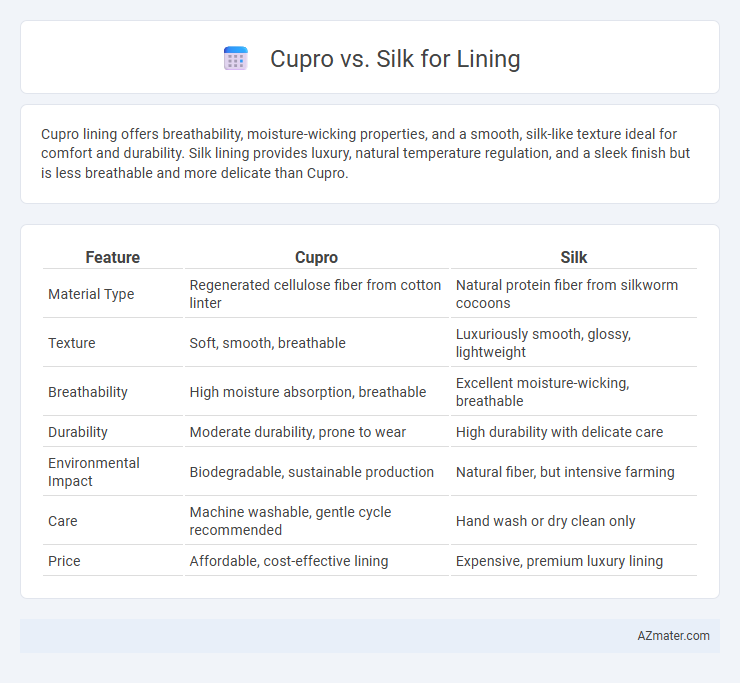Cupro lining offers breathability, moisture-wicking properties, and a smooth, silk-like texture ideal for comfort and durability. Silk lining provides luxury, natural temperature regulation, and a sleek finish but is less breathable and more delicate than Cupro.
Table of Comparison
| Feature | Cupro | Silk |
|---|---|---|
| Material Type | Regenerated cellulose fiber from cotton linter | Natural protein fiber from silkworm cocoons |
| Texture | Soft, smooth, breathable | Luxuriously smooth, glossy, lightweight |
| Breathability | High moisture absorption, breathable | Excellent moisture-wicking, breathable |
| Durability | Moderate durability, prone to wear | High durability with delicate care |
| Environmental Impact | Biodegradable, sustainable production | Natural fiber, but intensive farming |
| Care | Machine washable, gentle cycle recommended | Hand wash or dry clean only |
| Price | Affordable, cost-effective lining | Expensive, premium luxury lining |
Introduction: Cupro vs Silk for Lining
Cupro and silk are popular lining materials known for their smooth texture and breathability. Cupro, a regenerated cellulose fabric made from cotton linter, offers excellent moisture absorption and durability, making it a cost-effective alternative to silk. Silk provides a natural sheen and luxurious feel, renowned for its hypoallergenic properties and temperature regulation, ideal for high-end garments.
What is Cupro?
Cupro is a regenerated cellulose fiber made from cotton linter, offering a smooth, breathable, and hypoallergenic alternative to traditional linings like silk. Its moisture-wicking properties and ability to maintain shape make Cupro a practical choice for garment interiors, especially in suits and jackets. Unlike silk, Cupro is more durable and easier to care for, providing a luxurious feel while being eco-friendlier due to its biodegradable nature.
What is Silk?
Silk is a natural protein fiber produced by silkworms, valued for its smooth texture, lightweight feel, and excellent breathability, making it ideal for luxury garment linings. Its hypoallergenic properties and moisture-wicking abilities help regulate body temperature, enhancing comfort in various climates. Compared to Cupro, silk offers superior natural luster and durability, contributing to an elegant finish in high-end fashion linings.
Key Properties of Cupro Lining
Cupro lining is prized for its breathable, moisture-wicking properties that help regulate body temperature and enhance comfort. Its smooth, silky texture offers a luxurious feel similar to silk but with greater durability and ease of care. Cupro is also hypoallergenic and biodegradable, making it an eco-friendly choice for sustainable fashion lining.
Key Properties of Silk Lining
Silk lining offers exceptional breathability and moisture-wicking properties, making it ideal for temperature regulation and comfort. Its natural protein fibers provide a smooth, hypoallergenic surface that reduces skin irritation and enhances durability. The luxurious sheen and softness of silk contribute to an elegant feel, setting it apart from synthetic or semi-synthetic linings like cupro.
Comfort and Breathability Comparison
Cupro lining offers superior breathability due to its natural cellulose fiber composition, allowing better moisture absorption and ventilation compared to silk. Silk, while smooth and luxurious, tends to retain heat and moisture, making it less effective in promoting airflow during prolonged wear. For enhanced comfort in warm or humid conditions, cupro stands out as the preferred lining material over silk.
Durability and Maintenance
Cupro lining offers superior durability compared to silk due to its resistance to wear and moisture, making it ideal for long-lasting garments. Silk, while luxurious and smooth, requires delicate maintenance such as dry cleaning and careful handling to prevent damage. Choosing cupro ensures easier upkeep and extended garment life, particularly in high-use clothing items.
Sustainability and Environmental Impact
Cupro, a regenerated cellulose fiber made from cotton linter, offers a biodegradable and sustainable alternative to traditional synthetic linings, utilizing byproducts from cotton production that would otherwise be wasted. Silk, while natural and biodegradable, involves intensive water use and energy consumption in sericulture, raising concerns about its environmental footprint. Cupro's closed-loop production process reduces chemical waste and water pollution, making it a more eco-friendly choice compared to conventional silk lining.
Cost and Availability
Cupro is generally more affordable than silk, making it a popular choice for budget-conscious fashion brands and designers. It is widely available due to its production from cotton linter, a byproduct of cotton processing, ensuring steady supply and cost efficiency. Silk, on the other hand, tends to be more expensive and less consistently available, as it depends on labor-intensive sericulture and natural silk production cycles.
Which Lining Is Best: Cupro or Silk?
Cupro lining offers excellent breathability and moisture absorption, making it ideal for summer garments and sensitive skin, while silk lining is praised for its luxurious feel, natural temperature regulation, and smooth texture that enhances comfort in both warm and cool conditions. Cupro is a sustainable, plant-based fiber that resists static and provides a matte finish, whereas silk is a protein fiber known for its sheen and hypoallergenic properties. Choosing between cupro and silk for lining depends on prioritizing durability and eco-friendliness versus premium softness and natural elegance.

Infographic: Cupro vs Silk for Lining
 azmater.com
azmater.com